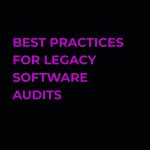Introduction
In today’s fast-paced digital world, businesses must continually adapt to stay competitive. Legacy software systems, which are older and often outdated technologies, can pose significant challenges to organizations. A legacy software audit is a comprehensive evaluation of these systems to identify potential risks, inefficiencies, and opportunities for improvement. So, let’s explore legacy audits for outdated software systems together. Let’s get started!
Understanding Legacy Software Systems
Legacy application systems are characterized by age and often use outdated hardware and software. They may lack proper documentation, making them difficult to maintain and update. These systems can be vulnerable to security threats, and their continued use can hinder a company’s ability to innovate and adapt to changing market conditions.

The Benefits of Legacy Software Audits
Conducting a legacy software audit offers numerous benefits for businesses:
- Improved Efficiency and Productivity: By identifying outdated processes and inefficiencies, legacy software audits can help organizations streamline operations and increase productivity.
- Enhanced Security: Legacy application systems are often more vulnerable to security threats. A legacy software audit can identify potential vulnerabilities and help organizations implement measures to protect their data.
- Enhanced Customer Experience: Outdated and legacy systems can negatively impact the customer experience. By modernizing legacy systems, businesses can improve their ability to serve customers effectively.
- Cost Savings: Legacy systems can be expensive to maintain. A legacy software audit can help organizations identify areas where costs can be reduced, such as by consolidating systems or migrating to the cloud.
- Risk Mitigation: Legacy audits can help businesses identify and mitigate potential risks associated with their legacy systems, such as data breaches or system failures.
Key Considerations for Legacy Software System Updates
When considering a legacy system update, there are several key factors to consider:
- Choosing the Right Vendor: It is crucial to select a vendor with the expertise and experience to handle your specific legacy system update.
- Data Migration Strategies: A robust data migration plan is essential to ensure your data is transferred safely and accurately.
- Integration with Existing Systems: Ensure the new system can integrate seamlessly with your IT infrastructure.
- Change Management Planning: Develop a comprehensive change management plan to prepare your employees and stakeholders to transition to a new system.
Conclusion
In today’s competitive business landscape, legacy software systems can be a significant liability. By conducting a legacy application audit, organizations can identify potential risks, inefficiencies, and opportunities for improvement. By addressing these issues, businesses can enhance their security, improve operations, and position themselves for long-term success.
If you’re considering a legacy software system update, now is the time to act. Contact us today to schedule a consultation and learn how we can help you modernize your systems and achieve your business goals.



